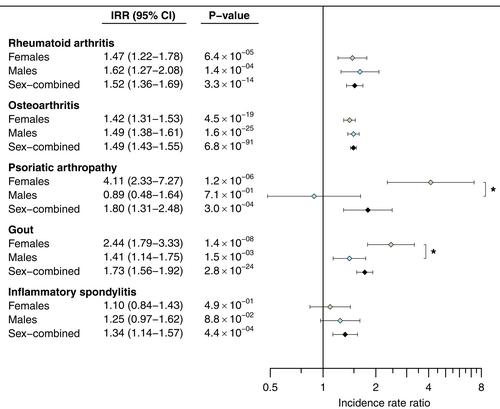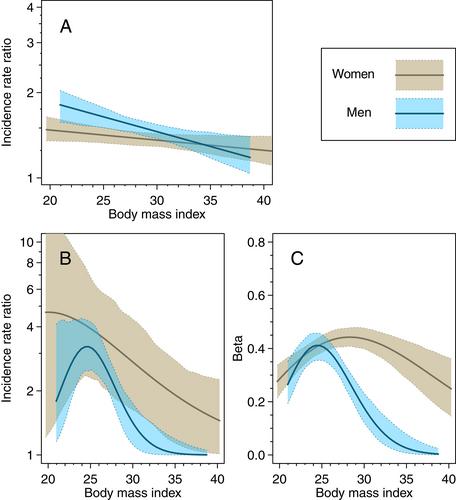Body Mass Index and the Risk of Rheumatic Disease: Linear and Nonlinear Mendelian Randomization Analyses
Abstract
Objective
Although the association between obesity and risk of rheumatic disease is well established, the precise causal relation has not been conclusively proven. Here, we estimate the causal effect of body mass index (BMI) on the risk of developing 5 different rheumatic diseases.
Methods
Linear and nonlinear mendelian randomization (MR) were used to estimate the effect of BMI on risk of rheumatic disease, and sex-specific effects were identified. Analyses were performed in 361,952 participants from the UK Biobank cohort for 5 rheumatic diseases: rheumatoid arthritis (n = 8,381 cases), osteoarthritis (n = 87,430), psoriatic arthropathy (n = 933), gout (n = 13,638), and inflammatory spondylitis (n = 4,328).
Results
Using linear MR, we found that 1 SD increase in BMI increases the incidence rate for rheumatoid arthritis (incidence rate ratio [IRR] 1.52 [95% confidence interval (95% CI) 1.36–1.69]), osteoarthritis (IRR 1.49 [95% CI 1.43–1.55]), psoriatic arthropathy (IRR 1.80 [95% CI 1.31–2.48]), gout (IRR 1.73 [95% CI 1.56–1.92]), and inflammatory spondylitis (IRR 1.34 [95% CI 1.14–1.57]) in all individuals. BMI was found to be a stronger risk factor in women compared to men for psoriatic arthropathy (P for sex interaction = 3.3 × 10−4) and gout (P for sex interaction = 4.3 × 10−3), and the effect on osteoarthritis was stronger in premenopausal compared to postmenopausal women (P = 1.8 × 10−3). Nonlinear effects of BMI were identified for osteoarthritis and gout in men, and for gout in women. The nonlinearity for gout was also more extreme in men compared to women (P = 0.03).
Conclusion
Higher BMI causes an increased risk for rheumatic disease, an effect that is more pronounced in women for both gout and psoriatic arthropathy. The novel sex- and BMI-specific causal effects identified here provide further insight into rheumatic disease etiology and mark an important step toward personalized medicine.



 求助内容:
求助内容: 应助结果提醒方式:
应助结果提醒方式:


